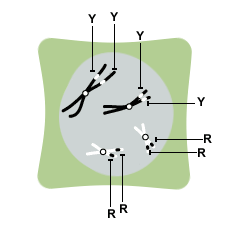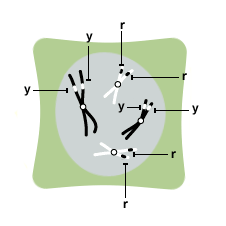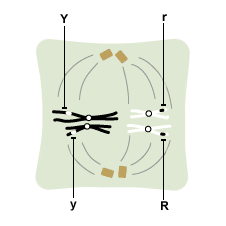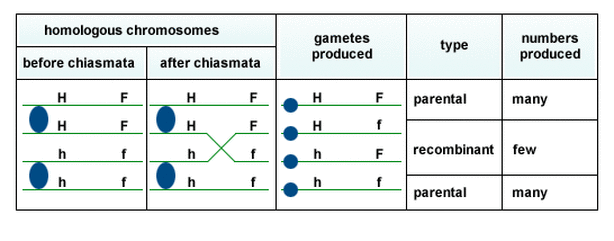The dihybrid crossTo understand the dihybrid cross it is necessary to understand the process of meiosis. You must have a clear understanding of the stages of meiosis. In the first meiotic division, the homologous pairs of chromosomes have aligned at random before being separated from each other. The separation of the chromosomes gives rise to the independent assortment of the chromosomes. In the second meiotic division, the four cells that are formed develop into haploid gametes.
All genetic crosses show how characteristics are inherited through the generations:
Colour and shape of pea plants
All genetic crosses show how characteristics are inherited through the generations:
- a monohybrid cross shows the inheritance of one through two generations. From parents to the F1 generation and then from the F1 generation to the F2 generation.
- a dihybrid cross shows the inheritance of two through two generations. In a dihybrid cross the genes that determine the two characteristics are located on different pairs of homologous chromosomes. Each of these genes can have two or more alleles.
Colour and shape of pea plants
Colour Y = allele for yellow seeds | y = allele for green seeds
Shape R = allele for round seeds | r = allele for wrinkled seeds
Shape R = allele for round seeds | r = allele for wrinkled seeds
Crosses have a recognised format and the structures of chromosomes are not shown. Instead, the letters used to identify the alleles of the genes are used to represent the chromosome. Thus, when showing a cross, YYRR would represent two homologous pairs of chromosomes. On one of the homologous pairs both alleles would be for the dominant form of the gene for seed colour and in the other, both alleles would be for the dominant form of the gene for seed shape.
Example 1
Show the results of a cross between the following pea plants through to the second generation:
Example 1
Show the results of a cross between the following pea plants through to the second generation:
- A homozygous (true-breeding) pea plant with yellow round seeds crossed with a homozygous pea plant with green wrinkled seeds.
- The allele for yellow (Y) is dominant to the allele for green (y).
- The allele for round (R) is dominant to the allele for wrinkled (r).
First stage of parental cross

First stage of parental cross
This shows a cell with two homologous pairs of chromosomes at the start of meiosis. The chromosomes have already replicated. The dominant allele for the gene for seed colour is present on both members of one of the homologous pairs(longer chromosome in diagram) and the dominant allele for the gene for seed shape on the other pair(shorter chromosome in diagram).
The first task is to show the cross to the F1 generation. In the format of the cross the phenotypes and genotypes of the parents must be shown together with the genotypes of the gametes that can be formed as a result of meiosis.
The first task is to show the cross to the F1 generation. In the format of the cross the phenotypes and genotypes of the parents must be shown together with the genotypes of the gametes that can be formed as a result of meiosis.
SummaryAll the F1 generation have the YyRr genotype because in meiosis the only gametes that can be formed will be YR in the yellow round seeded parent and yr in the green wrinkle seeded parent. All the F1 generation have a yellow round phenotype as they have all inherited copies of these dominant alleles from the yellow round seeded parent.
.

First stage of parental cross
Pea plants grown from the seeds of the F1 generation are crossed. In the format of the cross the phenotypes and genotypes of the parents must be shown together with the genotypes of the gametes that can be formed as a result of meiosis.
Four types of gamete are produced for each parent. This is the result of random alignment of the homologous pairs of chromosomes and their separation during the process of meiosis.
Diagram 1

First stage of parental cross
Diagram 1: Original Maternal and Paternal chromosomes aligned towards the same pole
Diagram 2

First stage of parental cross
Diagram 2: Original Maternal and Paternal chromosomes not aligned
The diagrams show the two different ways in which the homologous pairs may align before being separated.
Cross between members of the F1 generation
Diagram 1 - The homologous pairs have aligned in such a way that the chromosomes with the dominant alleles will be separated together at the next stage in meiosis and those with the recessive alleles will also be separated together.
Diagram 2 - The homologous pairs have aligned in such a way that a chromosome with a dominant allele of one of the genes will be separated together with a chromosome with the recessive allele for the other characteristic at the next stage in meiosis.
Each parent has produced the same four types of gamete. Fertilisation is a random process with an element of chance, therefore, any one of the gametes from one parent can fuse with any one of the four types of gamete of the other parent. These possible combinations of gamete are best shown in a Punnett square. The possible gametes of each parent are set out along different axis and the possible combinations of gametes shown within the squares:
Cross between members of the F1 generation
Diagram 1 - The homologous pairs have aligned in such a way that the chromosomes with the dominant alleles will be separated together at the next stage in meiosis and those with the recessive alleles will also be separated together.
Diagram 2 - The homologous pairs have aligned in such a way that a chromosome with a dominant allele of one of the genes will be separated together with a chromosome with the recessive allele for the other characteristic at the next stage in meiosis.
Each parent has produced the same four types of gamete. Fertilisation is a random process with an element of chance, therefore, any one of the gametes from one parent can fuse with any one of the four types of gamete of the other parent. These possible combinations of gamete are best shown in a Punnett square. The possible gametes of each parent are set out along different axis and the possible combinations of gametes shown within the squares:
When the phenotypes of the 16 possible combinations are identified, it is found that the expected ratio in the F2 generation is:
The results from such crosses show the expected ratios of the four different phenotypes.
The ratio produced in crosses can differ from the expected because it's a random or chance process, if the sample size is too small or if the genes being examined are both on the same chromosome (linked genes).
The phenotypes with the ratios of 3 (yellow, wrinkled and green, round) are known as recombinants because they contain a combination of both parental phenotypes.
Testcross (Backcross)Another common dihybrid cross is between individuals heterozygous for both characteristics and individuals homozygous recessive for both characteristics. This cross is shown using the same characteristics as in the previous example.
The ratio produced in crosses can differ from the expected because it's a random or chance process, if the sample size is too small or if the genes being examined are both on the same chromosome (linked genes).
The phenotypes with the ratios of 3 (yellow, wrinkled and green, round) are known as recombinants because they contain a combination of both parental phenotypes.
Testcross (Backcross)Another common dihybrid cross is between individuals heterozygous for both characteristics and individuals homozygous recessive for both characteristics. This cross is shown using the same characteristics as in the previous example.
Linked genesLinked genes are found on the same chromosome and are transmitted together, unless crossing over has occurred during gamete formation in a heterozygous parent.
The parental characteristics will be present in the offspring in approximately a 3:1 ratio of dominant to recessive. There will also be a small number of recombinants this important to increase variation within species.
This news clip from Oct 2008 reports that scientists have developed purple tomatoes (by crossing genes) which they hope may be able to keep cancer at bay.
This news clip from Oct 2008 reports that scientists have developed purple tomatoes (by crossing genes) which they hope may be able to keep cancer at bay.

